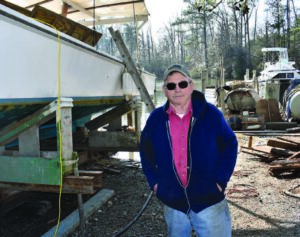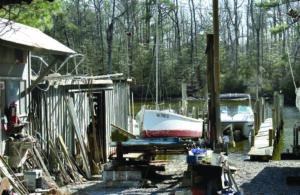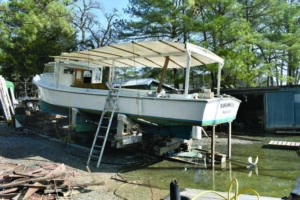
by Larry Chowning-
Charlie Mothershead started a small railway and boatbuilding operation in 1918 near Mila in Northumberland County on Cranes Creek off the Great Wicomico River.

The late Glenwood Sampson of Mila recalled in a 2006 interview that Mothershead was “an old-time boatbuilder with an old-time railway. He had a windlass that he turned by hand to get boats in and out of the water.”
In the early years of railways, strong arms, mules and horses were used to turn a windlass when hauling boats up on the rails to be repaired or painted. As gasoline engines evolved, one-cylinder engines (one lungers) became the main power for hauling boats. Model T Ford engines took the place of the one-lunger. As engines continued to advance, so did the size of railways, until some boatyards were able to haul 100-foot plus vessels.
Today, many boatyards in the Chesapeake Bay region have pulled up their rails and switched over to hauling vessels in the straps of motorized commercial boat lifts. There are, however, still a few old-time railways.
Mothershead’s old railway never got to the point of hauling 100-foot long boats, but today under the ownership of A.C. Fisher Jr., the traditional railway is still going and can haul boats up to 60 feet.

A.C. Fisher Jr. Marine Railway
As a student at Northumberland High School, Junior Fisher designed a railway cradle in shop class and went on to install it and operate the railway on Cranes Creek. He also fit in a career with Virginia Marine Resources Commission while running his railway.
When Fisher’s parents purchased the railway property in the 1960s, the old railway had been abandoned for years. “There was just a reminisce of the railway on the shore,” said Fisher. “I got interested in the railway when I was assigned a special project in shop class to design and build something. I picked for my project a metal railway cradle.
“I don’t think the shop teacher knew what a railway cradle was,” he said. “I designed and built the cradle and used it at the yard for 25 years before it wore out.”
Junior and his father Carl started the railway in 1968 and they ran it together until his father’s death in 1976. After his father died, Junior built the large railway in 1978, alongside the smaller one.
On the large rails, Fisher hauls about 30 boats a year—a blend of traditional wooden deadrise boats and fiberglass yachts and powerboats. The yard uses the small rail to maintain Virginia Marine Resources Commission’s small boat fleet and other small boats. There are few railways anywhere that cater to hauling skiffs. Part of Fisher’s attention to skiffs is because he is in the heart of the Northern Neck’s pound net fishery and small boats, used in that fishery, are as significant to pound net fishing as a 42-foot workboat is to crabbing and oystering.
In January, the 41-foot wooden deadrise workboat Nassawadox out of Reedville was up on the big rails getting a new horn timber installed. In wooden boat construction the horn timber ties the keel and transom together, with the propeller shaft running through the horn timber and skeg. A horn timber shapes a concave bottom near the stern. When the boat is under way, a concave bottom helps to keep the stern down, just touching the water, and aids the boat in staying level in the water. A solid piece horn timber is a tricky element to replace.

Andy Sisson of Mila was installing the horn timber. Fisher said Sisson is a master boat carpenter. Whenever there is a major job to do on a wooden boat at his yard Sisson is called in.
Amazingly, Fisher uses very little purchased milled lumber as he annually goes out into area forests and purchases and cuts down five spruce pine trees and a couple of white oak trees and has it milled locally for boat lumber. Fisher says out of the five pine trees he is “lucky” to get three that can be used for boat lumber because of the disease “red heart.” The two unusable trees are milled and sold for house lumber.
Red heart or “red ring rot” is a disease that ruins the tree for boat lumber use. “We can’t tell which trees have it until we cut it down,” said Fisher. Red heart is a disease usually found in mature pine trees, where the heart of the tree is infected by the fungus phellinus pini.
“The areas along the red colors in the heart of the tree are very susceptible to rot,” said Fisher. “The infected wood is fine to use as house lumber in places where water doesn’t touch it. I have it milled and sell it to house builders who come by.”
The new horn timber in the Nassawadox is shaped from a 12-inch by 12-inch by eight-foot long spruce pine timber and came from a tree Fisher and Sisson cut several years ago and cured at the railway.
“Fifty years ago, boatbuilders could get good lumber from a local sawmill, but they did not have very good fasteners,” said Fisher. “Today we can’t buy good boat lumber and that’s why we cut our own, but we have great fasteners. If old wooden boatbuilders had had the fasteners we have today, the boats would have lasted a lot longer.” The new horn timber is bolted to the keel with stainless steel bolts.
Rebuilding skiffs
Over the years, Fisher has rebuilt wooden 16- to 18-foot deadrise and flat-bottom skiffs used by commercial and recreational boaters. Twenty years ago he was rebuilding traditional sharpie skiffs.
Mothershead specialized in building double-ended, pointed at both ends, skiffs. Sharpies, as the boats were called, were used extensively before the days of peeler pots and crab scrapes to catch peeler crabs and soft-shell crabs. Watermen and homeowners used the double-ended skiffs to pole through the shallow water close to shore and dipped up soft-shell crabs with a crab net. A live well or small holding box was installed near the center of the skiff to store the catch. “Mr. Mothershead must have built hundreds of the skiffs, because for a long time people kept bringing them in for me to repair,” said Fisher.
Mothershead’s yard goes back to the era of when the family skiff was as significant to a household as the family car is today. Small boats were used to provide sustenance for a family by aiding in catching crabs, fish and oysters.
Back then, roads were often less significant for local travel than the shoreline of the nearby creek or cove. A trip across the creek to visit family and friends may have been a five-mile trip by road, but by water only a short row or scull in the skiff across the creek.
Fiberglass has brought change
Today, Fisher hauls wood and fiberglass boats. Boats made of fiberglass have changed the railway business, said Fisher. “We can haul more boats now,” he said, explaining that if he hauls a wooden boat on Monday morning, it has to dry all day and night before the bottom can be painted on Tuesday. A fiberglass boat dries out by mid-day Monday, and the work is done by quitting time Monday evening. And if it rains early Tuesday morning, the wooden boat is still on the railway and now can’t be painted until Wednesday.
“I love wooden boats, but a fiberglass boat gives us a quicker turnover,” Fisher said.
This was certainly not an advantage to Charlie Mothershead in 1918 as wood was all there was.





